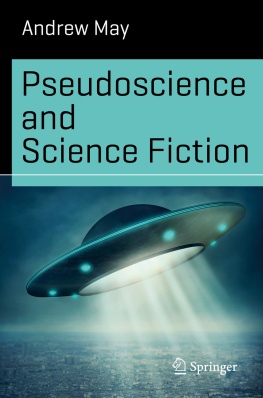Pulp Fiction
Long before the days of blockbuster movies, comics and video games, there were pulp magazines. The name comes from the fact that they were printed on cheap wood-pulp paper, as opposed to the glossy paper associated with more upmarket magazines. The pulps were cheap and plentiful, and they specialized in exciting, easy-to-read genre fiction with a mass appeal. It was in this context that science fiction, as a clearly defined genre of its own, made its debut in the 1920s. The scope of the new genre was potentially huge. As pulp historian and SF author Ron Goulart put it:
Science fiction could accommodate planet-hopping adventure, satiric thoughts about the future, trips through time to the past. Spacemen and monstrous aliens, fragile princesses, mad scientists, absent-minded professors and dedicated researchers. Hymns in praise of technology and dire warnings about the perils of the machine. Utopia and anti-utopia. Hard science, pseudoscience and crackpot science. []
All these things had existed before, but they had never been grouped under a convenient all-embracing label. An early SF fan, Alva Rogers, explained how the name came about:
The term science fiction, it might be noted here, was first used by Hugo Gernsback in the first issue of Science Wonder Stories [June 1929]. As near as can be determined this was the first time this particular combination ever saw print anywhere in any magazine. Until then the most popular term used to describe the literature was scientifiction, a word coined by Gernsback in 1925 and originally intended as the title for what became Amazing Stories . Scientifiction in turn was a contraction of scientific fiction, which was used extensively by Gernsback during the early twenties to describe the stories he ran as a regular feature in his magazine Science and Invention . []
Hugo Gernsback is often described as the father of science fiction. The Hugo awards, handed out each year at the World Science Fiction Convention, are named in his honour. Born in Luxembourg in 1884, Gernsback emigrated to America in 1904. He developed an interest in amateur radio and electronicscutting edge technology at the timeand founded one of the first magazines on the subject, Modern Electrics , in 1908.
Innovatively, Gernsback included fictional stories as well as factual articles in the magazine. Over the course of 12 issues in 191112, he serialized his own first novel, Ralph 124C 41 +, set in the year 2660. As Gernsback explained in the original foreword to the novel: It is intended to give the reader as accurate a prophecy of the future as is consistent with the present marvellous growth of science []. In retrospect, Gernsbacks prophecies can be seen as a mixture of valid technological extrapolationtelevision, videophones, driverless vehicles, solar power, spaceflightand outright pseudoscience, such as telepathic writing, invisibility and antigravity.
In 1913 Gernsback brought out his second magazine, The Electrical Experimenter , which later changed its title to Science and Invention . It followed the same formula as Modern Electrics , mixing popular science and fiction. The big change came in April 1926, with the debut of Amazing Stories (see Fig. )a magazine devoted entirely to scientifiction, as Gernsback explained in his editorial in the first issue:
Fig. 1
The first issue of Amazing Stories , April 1926 (public domain image)
Amazing Stories is a new kind of fiction magazine! It is entirely newentirely differentsomething that has never been done before in this country. Therefore, Amazing Stories deserves your attention and interest.
There is the usual fiction magazine, the love story and the sex-appeal type of magazine, the adventure type, and so on, but a magazine of Scientifiction is a pioneer in its field in America.
By scientifiction I mean the Jules Verne, H. G. Wells, and Edgar Allan Poe type of storya charming romance intermingled with scientific fact and prophetic vision. []
That first issue of Amazing Stories contained reprints of works by all three writers mentioned by GernsbackPoe, Verne and Wellsas well as several other authors. One of the newer stories to be featured was The Thing from Outside by George Allan England, which had originally appeared in Gernsbacks Science and Invention in April 1923.
The Thing from Outside is far from being a charming romance intermingled with scientific fact and prophetic vision. Its a tale of fear, paranoia and contradictory perceptions. Strange footprints appear on barely accessible rock ledges. There are hints of a sinister, invisible visitor from interstellar space or the fourth dimension:
I tell you, insisted Jandron, there are forms of life as superior to us as we are to ants. We cant see em. No ant ever saw a man. And did any ant ever form the least conception of a man? These Things have left thousands of traces, all over the world. Charles Fort, the greatest authority in the world on unexplained phenomena, gives innumerable cases of happenings that science cant explain, in his Book of the Damned . He claims this earth was once a no-mans land where all kinds of Things explored and colonized and fought for possession. And he says that now everybodys warned off, except the Owners. I happen to remember a few sentences of his: In the past, inhabitants of a host of worlds have dropped here, hopped here, wafted here, sailed, flown, motored, walked here; have come singly, have come in enormous numbers; have visited for hunting, trading, mining. They have been unable to stay here, have made colonies here, have been lost here. []
This was not the first time that extraterrestrial creatures had appeared in a work of fiction. What set Englands story apartand presaged a whole new sub-genre of pseudo-factual fictionwas its reference to Charles Fort: a real person, still living at the time the story appeared.



















